Fantail Pigeon: Breed Guide (With Infographic)
Did you know that both the male and female of the Fantail pigeon breed take turns incubating their eggs throughout the day? Talk about loving parents! And that’s not even the most interesting trait of this breed of pigeons.
What makes Fantail pigeons stand out as a unique pigeon breed is their tail, which has a shape similar to a fan. The birds use this characteristic for different purposes, such as when the male starts courtship to get the attention of the female.
Similarly, it’s this peculiar tail that makes Fantails beautiful birds for ornamental and show purposes.
Breeding and raising a Fantail is a unique experience, primarily because of the bird’s behavior and personality. Want to know how the process goes? Stick around to learn more about it, as well as everything about this breed and how to breed them successfully.
Fantail Pigeon Profile
| Name | Fantail Pigeon |
|---|---|
| Scientific Name | Scientific Name Columbia Livia Domestica |
| Common Names | Peacock Pigeons Mahakali Pigeons |
| Origin | Origin India, China, Spain & Pakistan |
| Size | Size 13.4 Inches (34 cm) |
| Weight | Weight 400 – 525 Grams |
| Lifespan | 10 to 20 Years |
| Physical Features | Medium-sized birds with puffy feathers and a rounded-up build, featuring heads slightly buried between their breast |
| Temperament | Gentle & Docile |
| Behavior | Behavior Curious & Caring |
| Special Features | Gracious Fan-Shaped Tail With 30 to 40 Feathers |
| Breeding and Maintenance | Relatively Easy |
| Common or Popular Varieties | Multiple Colors Like White, Black, Yellow, Brown, and Others |
Overview
A Fantail pigeon is a captivating, exotic, and fancy bird of unmatched beauty. Popular for its ornamental uses, this bird has gained fame worldwide due to its mesmerizing appearance.
For this reason, breeders also started to breed this type of pigeon as pets and show birds.
Looking for more articles about pigeons breed:
History, and Origins of Fantail Pigeons
This breed of pigeons has one of the most interesting histories. While the pigeons originated in one country, breeders from different areas of the world contributed to making the Fantail pigeons what they are today.
The history and origin of Fantail Pigeons
The estimated origin of the Fantail pigeons dates back to 1150 in Spain, making this breed one of the oldest fancy pigeons. However, the exact point in the history of their appearance is unclear. Other records show that the Indian Fantail variation first appeared in 1560 AD.
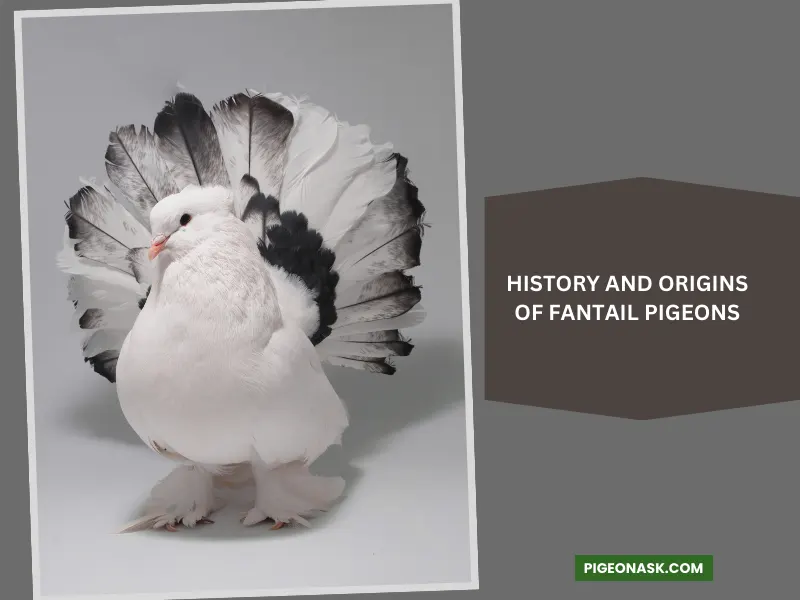
China, Pakistan, and Japan are other places attributed to the origin of this type of bird during the 16th century.
On the other hand, the earliest record of American Fantail pigeons in America dates back to the 20th century. In this case, the United States and Pakistan are often regarded as responsible for breeding this variation.
Interestingly enough, Charles Darwin was one of the first sources to introduce the Fantail pigeon. He included it as an example in the first chapter of On the Origin of Species, and he theorized the breed was a rock dove (Columbia livia) descendant. As expected, he was right.
What does the Fantail pigeon symbolize?
The ‘White Fantail’ pigeon symbolizes peace and harmony. Around the world, people believe the innocence of the pigeon represents peacefulness and calmness.
Why are these pigeons chosen as a symbol of peace?
Fantail pigeons are chosen as a symbol of peace because of the purity associated with their white color.
Likewise, the innocent eyes and docile personality contribute to the general perception of what these pigeons represent. They are a reminder that human beings shall be loving and compassionate to one another.
How They Were Bred and Developed
Fantails arrived in Europe thanks to merchants, and the appearance of the bird was not the same as it is today.
It was only until English and Scottish breeders stepped in that the Fantails became what they are today. Then, breeders started exporting the pigeons to the United States, and they became world famous.
While there are different types of Fantail pigeons, the American bloodlines are primarily two. The first one is the result of using Giant Hungarians for breeding, and that’s the reason they have pronounced shell crest and considerable muffs.
On the other hand, breeders used Giant Runt in the development of the other American Fantail pigeons. These have a unique peak crest and small muffs paired with long wings and lengthy feathers.
Subsequent cross-breeding and many years later, breeders managed to develop a perfect fan-like tail and more than ten colors.
Physical Characteristics and Features
You’ve probably seen Fantails and never knew their actual name. Learn more about the physical characteristics and features that make this bird unique. For this study, we will mostly be discussing the American Fantail pigeon.
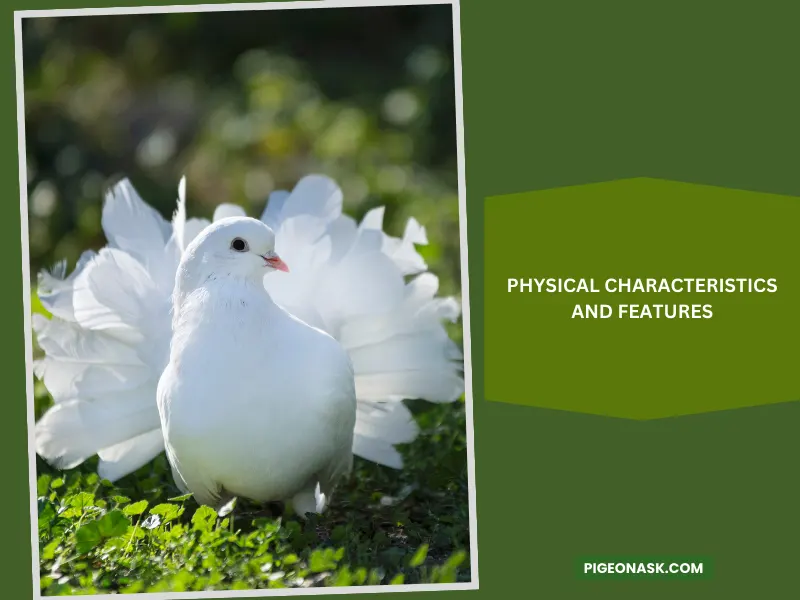
Size, Appearance and Body Structure
Fantail pigeons grow up to become medium-sized birds, with an average size of 13.4 inches, or 34 centimeters. Due to their puffy feathers and build, the structure of the pigeon is very interesting.
Generally, the birds have their head pretty much buried between their breast. This shape is more prominent because the pigeons tiptoe and lean back.
Weight
The usual weight of Fantail pigeons is between 400 and 525 grams. This makes the birds medium-sized, but it can also become a disadvantage. When they’re heavy, the pigeons usually have a hard time flying.
Unique Features
The most captivating feature of Fantail pigeons is their tails precisely. This breed of pigeons has tails that resemble a fan, with 30 to 40 feathers that spread out graciously when the bird is flying or feeling excited.
Typically, the birds also use this tail for courtship.
Some Common Variations in Colors and Markings Across Different Species
The wide color variety of Fantail pigeons is one of the reasons why they’re so popular and ideal ornamental birds. For instance, pigeons can be white, black, blue, silver, yellow, and red.
While some are only one color, others can be a mix of two. These intricate patterns make the birds more captivating and create incredible patterns like bars and checks.
Behavior and Traits of Fantail Pigeons
Typically, Fantail pigeons are some of the easiest bird breeds to manage. They’re easy-going, very cooperative, and they make the incubation and hatching phase easier.
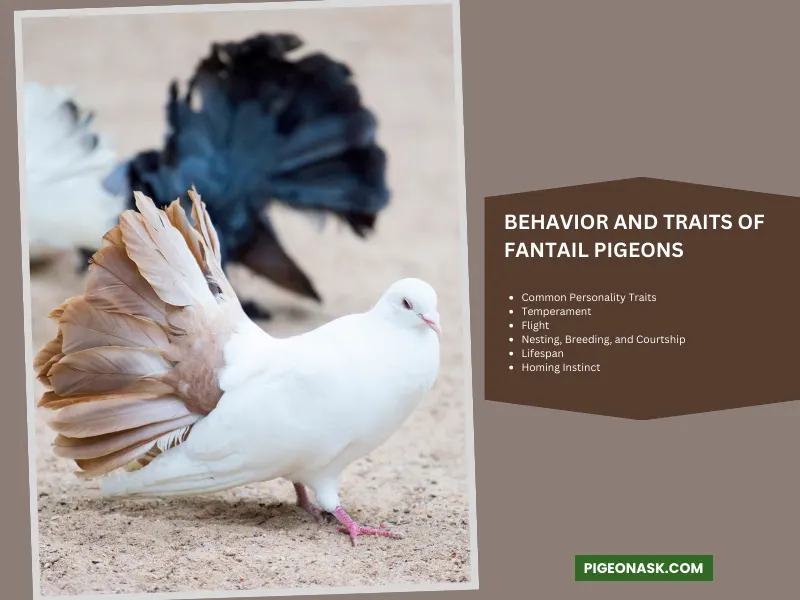
These are the usual behavior and traits for which you will love handling this pigeon type.
Common Personality Traits
Birds are usually curious, but Fantail pigeons take it up a notch. They like to explore and understand their surroundings, which can be a disadvantage because they’re generally vulnerable to predators.
Other than that, the personality of a Fantail pigeon is very convenient for breeders. The birds are loyal, quiet, and excellent parents to their young babies.
Temperament
If you ever wanted to breed pigeons but struggled with their temperament, you will find Fantail pigeons to be the ideal breed for you.
These birds are docile, calm, and very friendly to humans. Startling them is not easy either, meaning they make great pets you can care for thoroughly.
Plus, they don’t make plenty of noise, which is great if you appreciate a peaceful environment.
Flight
Fantails are decent learners, and they develop the ability to fly in approximately 30 days, after which they can be free from the nest.
But, are Fantail pigeons good at flying? However, this breed of pigeons is not good at flying, not even when they’re older. They take a considerable to reach close distance, flying for about three or four roofs before landing.
Usually, the flight duration of a Fantail pigeon is one minute. The main problem affecting the ability to fly is the huge tails, which become an obstacle when the pigeons take flight. Others may be too heavy, while others just have weak wings.
For these reasons, it’s dangerous for these pigeons to fly in the open.
Nesting, Breeding, and Courtship
One thing to keep in mind is that this species is monogamous, meaning the male and female mate for life.
The mating season of Fantail pigeons is during summer and spring, and it’s the start of a beautiful courtship ritual started by the male.
During the season, the male pigeon displays a gracious dance with their tail fan to get the female’s attention. They then rear their broods and exchange affection for several days.
The end of the mating period leads to the next phase, in which the pair start loading sticks to build a nest.
For 19 days, the female will incubate the eggs, sitting on them starting in late afternoon and deep into the night. During the day, the male does the same.
After the eggs hatch, the male and female take care of their baby offspring. Initially, the first food the youngsters must have is pigeon milk or crop mil.
This substance is a bit cheesy and first appears on the parent’s crops during the hatching phase. The baby Fantail pigeons receive this for over a week, and then the parents begin regurgitating digested grains for the little ones.
Lifespan
The average lifespan of Fantail pigeons is 15 years. Of course, how much the pigeon actually lives will depend on the living conditions, food, and security from predators. A well-fed Fantail pigeon with its own space and a rich diet will live for longer.
Homing Instinct
Fantail pigeons don’t have a strong homing instinct and may get lost if they fly a considerable distance from home.
Besides, allowing the bird to fly outside would be an even risk if there are hawks or other predators. Since Fantail pigeons fly very slowly, they are vulnerable targets.
Just keep them on a loft with an attached aviary, and they should be fine.
Breeding and Maintenance
This type of pigeon is very cooperative, especially when it comes to breeding and hatching eggs. Still, the breeder must improve the living conditions to guarantee the pair have healthy offspring.
Here’s what you have to do.
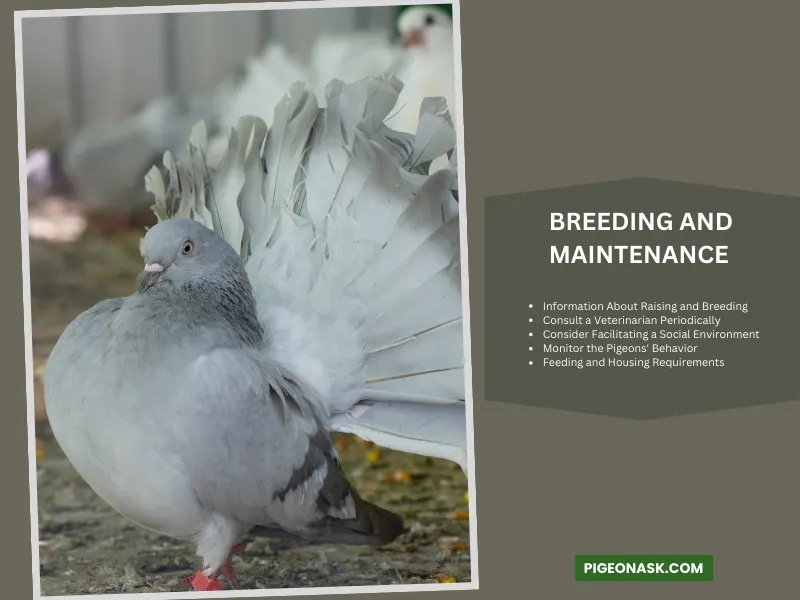
Information About Raising and Breeding
Take your time before selecting a pair of Fantail pigeons, and make sure they’re healthy, similar in age, and compatible in temperament or personality. This will make the experience easier for you and the birds.
Take special care of the baby chicks, too. After hatching, keep the parents well-fed and hydrated so they can take good care of the little chicks.
And don’t forget to separate the youngsters from their parents after four weeks to avoid inbreeding.
If you follow these instructions, you’ll have a bigger chance of breeding and raising Fantail pigeons. They will be good-looking, healthy, and loyal pets if that’s the purpose of the breeding.
Wait, do Fantail Pigeons make good pets? Fantail pigeons do make for great pets. They are friendly to humans and can coexist with other pets in the house if the conditions are correct. Likewise, their docile and peaceful behavior guarantees they won’t be troublesome.
Some Tips and Considerations for Successful Breeding
Not sure how to create the perfect conditions for the Fantail pigeon breeding? Check out the following tips that will help you out.
Consult a Veterinarian Periodically
Have a professional perform routine checkups, and keep up to date with vaccines, deworming procedures, and other measures necessary to keep the birds healthy.
Consider Facilitating a Social Environment
Since these pigeons are curious, it’s in their nature to be social. Consider introducing more pigeons over time. It will allow them to be more comfortable and feel less stressed a benefit to facilitate breeding.
Monitor the Pigeons’ Behavior
If you notice signs of aggression, separate the birds and assign specific spaces for them. This would mean that they’re not compatible.
Feeding and Housing Requirements
While the pigeons can build their nest, you still must provide the supplies for them so they can get it done. This means you shall create a pleasant environment that is comfortable and also safe.
For example, the space shelter must have good ventilation and be waterproof. Therefore, a coop or aviary matching these requirements would be ideal for Fantail pigeons.
As for the spacing, Fantail pigeons don’t need super spacious areas due to their size. So, any shelter of two to three square feet would be
comfortable enough. They will move freely and have their space, too.
Now, Another Question Arises. What do you feed Fantail pigeons? Fantail pigeons have a rich diet filled with nutrients and supplements. You can feed them a variety of pigeon mix, grains like corn, wheat, millet, and even seeds and nuts.
This breed of pigeons also enjoys veggies, so you can feed them ground carrots, lettuce, and garlic greens.
Other foods you can include in your pigeon’s diet are apples, oranges, unsalted sunflower seeds, peas, and Milo. You also must provide grit to support the pigeon’s absorption and increase calcium content.
Oh, and create a good feeding schedule, too! Provide the food and water early in the morning, and repeat the same treatment during the evening. Throughout the day, feed them with supplements to keep them well nourished.
Related Subvarieties of Fantail Pigeons
The wide popularity of Fantails means that this pigeon breed has found a home in many countries. These are the most common.
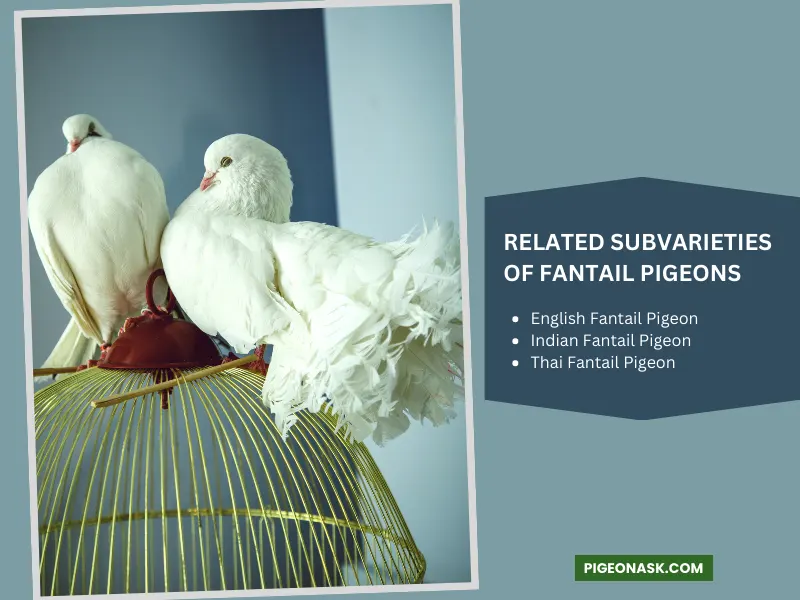
English Fantail
The English fantail is easily the most popular breed of this fancy pigeon family. People also know it as Garden Fantail and has a common conservation status.
Likewise, the most common use for this type of Fantail is exhibition.
Indian Fantail
As the name suggests, this type of Fantail originated in India. Typically, the Indian Fantail is bigger than the English Fantail, and they have feathers on their feet and crest.
Another difference is the body structure. While the English Fantails have their chest upright, the Indian Fantail stands completely upright.
Thai Fantail
The Thai Fantails originated after importing Indian Fantails to Thailand. Once in this country, the structure and appearance of the pigeon breed changed over time. Thai Fantail pigeons are usually smaller and lighter.
FAQ
How much are Fantail pigeons?
The price for a pair of pure American Fantail pigeons is between $200 and $300. This price range applies to most countries worldwide but not Pakistan and India. In these two countries, you usually pay approximately $100 and $130 per pair.
Do Fantail pigeons perch?
Yes, Fantail pigeons perch. They do it mostly on roofs and lofts, but you can train them to perch on your hand or shoulder. This is a good thing. Since they’re not good flyers, it would not be wise to let the pigeons outside and wait for them to come back and perch at home.
Can fantail pigeons live with chickens?
Fantail pigeons can live with chickens as long as each bird has their own space. Ideally, you should set up a perch per bird to avoid conflicts. Since chickens are usually bigger, they can peck at smaller Fantail pigeons and cause harm.
Final Word
There’s no denying the beauty of a Fantail pigeon. Whether it’s for their good looks, peculiar tail shape, or just their pleasant behavior, Fantails are among the most satisfying pigeon breeds to raise.
Plus, their many purposes guarantee there’s a place for them in the shelter of every breeder!
Do you find pigeon breeds as interesting as we do? Then don’t miss out on all of our other articles where we discuss all sorts of pigeon-related information and much more!
Follow us on Facebook, Twitter, and Pinterest to keep you informed.
Image Credit:
- Canva.com/photos
